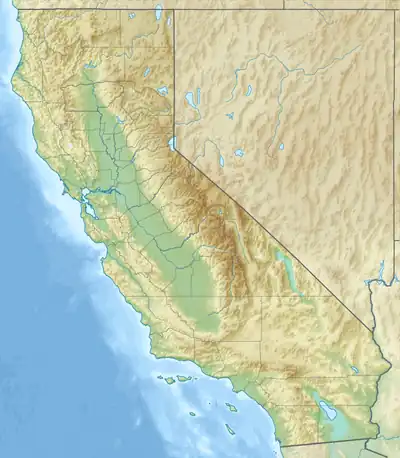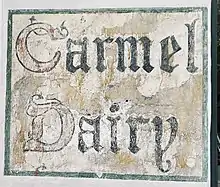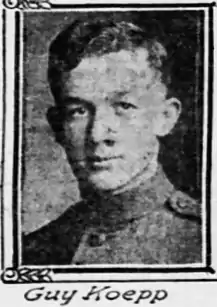Reardon Building
The Reardon Building also known as the Carmel Dairy Building is a Spanish Eclectic style two-story commercial building in downtown Carmel-by-the-Sea, California. The Reardon building is an example of early inventive commercial design for advertising and marketing. The building was designated as a significant commercial building in the city's Downtown Historic District Property Survey, and was recorded with the Department of Parks and Recreation on January 20, 2002.[1] Since 2001, the building has been occupied by Palomas Home Furnishings.
| Reardon Building | |
|---|---|
| Carmel Dairy | |
.jpg.webp) Reardon Building c. 1932 | |
| Location | NW Corner Ocean & Mission Carmel-by-the-Sea, California |
| Coordinates | 36°33′20″N 121°55′24″W |
| Built | 1932 |
| Built by | Caryle Stoney |
| Built for | Thomas B. Reardon |
| Original use | Carmel Dairy |
| Current use | Retail store |
| Architect | Guy O. Koepp |
| Sculptor | Jo Mora |
| Architectural style(s) | Spanish Eclectic |
| Website | www |
 Reardon Building Location in California  Reardon Building Location in United States | |
History

The Reardon Building was named for Thomas B. Reardon, a Carmel pioneer who arrived in 1906. He was a member of the Carmel Arts and Crafts Club and the Forest Theater. He served on the Carmel City Council from 1919 to 1924 and was founder of the Carmel Savings & Loan Association. The Reardon estate hired architect Guy O. Koepp to design the building for the Carmel Dairy, a business owned by Earl F. Graft, who was in the dairy business for 27 years.[2][1]
The Carmel Dairy sold milk products produced by the William Hatton Dairy and the Martin farm (now occupied by the Mission Ranch). Caryle Stoney was the original contractor. Jo Mora was commissioned by Graft to decorate the building. Mora made three large interior dairy murals above a soda fountain (no longer present) and a sculptured a metal lamp in the shape of a cowbell that still hangs above the buildings front door. He showed animal figures dressed as humans, many recognizable as local Carmel residents. He also designed the menus, Christmas cards, and milk bottles, with these animal characterizations, and a cow that served as the logo.[2] The Santa Rosa Republican described Mora's work with an article having the title: "Carmel's Prosaic Dairy is Art."[3]
The Carmel Dairy sign still exists on the exterior of the building along Mission Street. Koepp's designed a corner tower to resemble a milk bottle shaped polygonal tower and a Mission tile cap as the exterior centerpiece. The building is located on Ocean Avenue and Mission Street. The Stucco walls, arcaded windows, and title roof are examples of conventional Spanish Eclectic style. The building is significant example of early inventive commercial design for advertising and marketing. It is also one of the buildings that represents Carmel's Downton Historic District.[1][4]
The building was reviewed in the Carmel Pine Cone on March 17, 1932, saying:
Jo Mora, Guy Koepp and the latest scientific and hygienic apparatus for delivering milk to the public, have combined to make the new home of the Carmel Dairy at Ocean and Mission probably the most unique institution of its kind in existence....And Carmel is indebted to the late Thomas Reardon for having the vision to construct a building of lasting architectural value."[5]
The Carmel Diary went out of business at the end of World War II, and the building was leased as a soda fountain for several years. In 1953, the Italian grocer Joe Bileci and Horace Coniglio moved his Mediterranean Market from San Carlos Street to the Carmel Dairy building. They added Portuguese tiles on either side of the entry as well as Spanish design exterior light fixtures. In 1955, Bileci hired architect Francis Palms to remodel the rear of the building.[1] After 40 years in business, the Mediterranean Market was closed in 2001.[6][7]
Guy O. Koepp

Architect Guy Oran Koepp (1896–1959) was born on May 19, 1896, in Oregon. His parents were Albert F. Koepp (1867-1930) and Laura Ellen Baker (1869-1945). He was a graduate of the University of Oregon.[8]
He served in World War I with an aviation corps at Long Island, New York.[9] He married Gertrude Beulah Elizabeth Zahrah Lee (1893-1960) on December 31, 1924, in Hollywood, California and had five children.[10]
He was a Carmel building designer who came to Carmel in the early 1920s. He designed the Reardon Building (1928), American Legion Post No. 512 (1928), La Rambla Building (1929), E. H. Cox House (1930), Reardon Building (1932), Goold Building (1935), and other buildings in Carmel-by-the-Sea.[11][4][1]
He died on August 3. 1959, in Los Angeles, California, at age 63. Private funeral services were held at the Pierce Bros. Hollywood Mortuary.[8]
See also
References
- Kent L. Seavey (January 20, 2002). "Department Of Parks And Recreation" (PDF). National Park Service. Retrieved March 24, 2022.
- Hudson, Monica (May 24, 2006). Carmel-by-the-Sea. Carmel-by-the-Sea, California: Arcadia Publishing Incorporated. ISBN 9781439614570. Retrieved 2022-03-24.
- "Carmel's Prosaic Dairy is Art". Santa Rosa Republican. Santa Rosa, California. 9 Oct 1933. p. 3. Retrieved March 24, 2022.
- Seavey, Kent (2007). Carmel, A History in Architecture. p. 114. ISBN 9780738547053. Retrieved 2022-01-16.
{{cite book}}:|work=ignored (help)CS1 maint: location missing publisher (link) - "Where Art And Hygiene Meet by Hal Garrott". Carmel Pine Cone. Carmel-by-the-Sea, California. June 17, 1932. Retrieved March 24, 2022.
- "The Carmel Dairy Building by Michael Chatfield". Carmel Magazine. Carmel-by-the-Sea, California. 2022. Retrieved 2022-03-25.
- "Historical Context Statement Carmel-by-the-Sea" (PDF). City of Carmel-by-the-Sea. Carmel-by-the-Sea, California. 1994. p. 20. Retrieved 2022-03-25.
- "Guy O. Koepp". Los Angeles Evening Citizen News. Hollywood, California. 5 Aug 1959. p. 18. Retrieved 2022-03-30.
- "Eugene Boy Writes Home From U.S. Army Camps, Guy Koepp Praises Work of the Y.M.C.A". Morning Register. Eugene, Oregon. 15 Nov 1917. p. 8. Retrieved May 24, 2022.
- "Historical Information for Guy Oran Koepp". FamilySearch. Retrieved 2022-05-24.
- Dramov, Alissandra; Momboisse, Lynn A. (2016). Historic Homes and Inns of Carmel-by-the-Sea. p. 29. ISBN 9781439656747. Retrieved 2022-03-30.
{{cite book}}:|work=ignored (help)